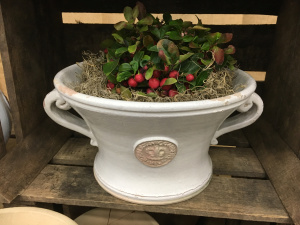This week I attended the Mid-Atlantic Nursery Trade Show (MANTS), an annual horticulture trade show at the Baltimore Convention Center. MANTS is one of the largest shows with over 10,000 attendees and almost a thousand companies exhibiting at booths in the Convention Center. The companies are wholesale, they are not selling directly to customers or the press like me. However, I enjoy attending because it provides me a glimpse of new products and plants and trends in the gardening world. This year, I discovered several new plants and gardening products which I will describe in future articles.
One plant in particular stood out for me. I was struck by how many times I saw Gaultheria procumbens in containers either as a decoration or as a new cultivar. I have seen the species for sale in local nurseries before but they were always so small and scrawny I never bought them. The plants at MANTS were large with exceptionally large berries.
Briggs Nursery had a display of Berry Cascade and Cherry Berries. Cherry Berries has very large red berries, almost like cranberries, while Berry Cascade had berries appearing the entire length of the stem, forming a cascading effect. Because Briggs is a wholesale nursery, you would have to ask your garden center to order these if they don’t already have them in stock.

Cherry Berries

Berry Cascade
Monrovia, a plant company that sells directly to consumers via their website and through garden centers, had beautiful, healthy plants in their signature containers. Their website features two types: Very Berry and Red Baron. Red Baron has more and larger bright red berries.

Monrovia’s Gaultheria plants
I was lucky to find Peppermint Pearl at MANTS. Peppermint Pearl is unusual in that the berries first appear white in the fall and change to pink by early spring.

Peppermint Pearl, already turning from white to pink
Botanical Collections, a wholesaler of Kew pottery from London’s Royal Botanic Gardens, used the red berries of Gaultheria to show off their products.

Red berries add color to Botanical Collections’ pottery
And here is another photo of Gaultheria modeling this container.

Gaultheria procumbens, also known as teaberry or wintergreen, is a groundcover that prefers shade and moist, acidic soil (think “woodsy environment”). Hardy to zone 3, Gaultheria is an eastern North American native plant. It blooms small, white flowers in the summer followed by the berries in the fall. The berries can last until spring and are edible but it is the leaves that produce that aromatic wintergreen scent. Native Americans used the leaves to make a medicinal tea, hence teaberry, to alleviate pain (much like aspirin). The name wintergreen comes from the fact that the plant is an evergreen. Its green leaves turn bronzy red or purple with the cold weather and remain above ground throughout the winter. Although the plant should be grown outdoors, its red berries make it a great holiday gift plant. Now that there are new cultivars with even larger berries, I will have to add Gaultheria to my Virginia garden as a native herb evergreen groundcover with winter interest!
Share this:




